The Common Snakes of Durban
There are eighty-three different types of snakes found in Kwa-Zulu Natal, of which fourty-four species are not venomous; eight can cause painful—although not lethal—bites; and, eleven that are known to be potentially deadly.
With Durban being located along the eastern coast of Kwa-Zulu Natal, it’s well known for its temperate climate, lush coastal forests, high humidity and plentiful rainfall. It’s densely populated with multiple eco-estates, complexes and homes being built right in between these pockets of coastal bush, often creating fragmented habitats for many animals. These fragmented habitats lead to a high number of human/animal conflicts, including multiple snake encounters, particularly during the warmer months between September and March
Be sure to also read Common Harmless Snakes of South Africa
Black mamba (Dendroaspis polylepis) – VERY DANGEROUS
Undoubtedly the most iconic and feared snake in Africa, mostly without reason, as these snakes do not readily feature in snake bite statistics in Durban. They’re the largest venomous snake in Durban, and can reach a maximum of 4.5m. Specimens of this size are exceptionally rare and none have been seen or measured in close to 50 years. Typically these snakes are on average 2.5m – 3m.
Green Mamba (Dendroaspis angusticeps) – VERY DANGEROUS
The smaller and more docile cousin of the Black Mamba, the Green Mamba averages only 1.8m with a maximum size of around 2.5m. It is a tree-dwelling species largely restricted to dense coastal forests, from the Bluff in the south through to Ballito in the north. These snakes are not found far from the coast and are seldom found more than 7 kilometres from the sea. If you cannot hear, smell or see the sea, it’s safe to say you will not find Green Mambas in the area. However, there is always the odd exception.
Mozambique Spitting Cobra (Naja mossambica) – VERY DANGEROUS
This is one of the most common, highly-venomous snakes found in and around Durban. The Mozambique Spitting Cobra is responsible for the majority of the serious snake bites that occur in Kwa-Zulu Natal, particularly in the Northern regions. Averaging only 1.2m in length, these snakes are commonly found in the west of Durban; often in residential gardens particularly, those bordering nature reserves. Their activity peaks just as the first rains of summer arrive, coinciding with the increase in amphibian activity. As their name suggests, this snake can spit/spray its venom with incredible accuracy, reaching targets up to 3m away.
Common Boomslang (Dispholidus typus viridis) – VERY DANGEROUS
These snakes are strictly tree-dwelling animals and seldom venture down to the ground, with the exception being to feed or drink. Boomslangs are not commonly found in Durban due to their secretive nature and excellent camouflage. They are one of the few snakes in Southern Africa that are sexually dimorphic, meaning that the males and females feature different colouring. Often the males are bright green, and the females dull brown/grey or olive. Juvenile snakes are brown/grey with speckles, and have a brilliant emerald-green eye. Averaging around 1.5m in length, Boomslangs can often reach close to 2m. These snakes rarely bite people, and are docile in nature. They possess a potent haemotoxic venom, for which there is an antivenom available. It solely deals with bites from these snakes, and is called a monovalent antivenom.
Twig Snake (Thelotornis capensis capensis) – VERY DANGEROUS
Although these are common snakes in the Durban area, they are seldom seen due to their strictly arboreal nature and cryptic camouflage. As their name suggests, they are found in dense shrubs, bushes, and garden hedges where they actively hunt lizards and chameleons. These snakes average around 1.2m in length, but can reach close to 1.5m in extreme cases. These snakes are docile in nature and seldom bite, however, when accosted these snakes will inflate their throats, making themselves look a lot larger, much like the Boomslang. Most bites from these snakes are the fault of irresponsible snake handlers who underestimate the Twig snake. They have a potent haemotoxic venom for which there is no antivenom. Thankfully bites are extremely rare, and there has not been a death in South Africa from these snakes in recent history.
Puff Adder (Bitis arietans) – VERY DANGEROUS
Probably South Africa’s most widely-spread, common venomous snake, the Puff Adder is relatively scarce in Durban itself, only being found just west of Durban. The Mozambique Spitting Cobra (Naja mossambica) and the Puff Adder account for the majority of serious snake bites in Kwa-Zulu Natal. The Puff Adder is a snake with excellent camouflage, and it prefers to sit and wait for opportunity when it comes to feeding. These snakes may remain in an ambush position for several weeks, waiting for a potential meal to pass by. They have a powerful cytotoxic venom which can lead to extreme pain, severe swelling, and blistering of the skin.
Rhombic Night Adder (Causus rhombeatus) – DANGEROUS
The Night Adder is a common snake, often found in damp areas of suburban gardens. These snakes have a strong venom and, although not capable of causing death in an adult, they are often underestimated. Many negligent snake handlers are bitten by these snakes. Feeding exclusively on frogs and toads, Night Adders can often be found around water features, rockeries, and pool pumps where they seek their prey. Despite the common name, the Night Adder is active mainly during the day. After the first summer rains—which brings the return of frogs and toads—Durban can be overrun with these snakes. They can be easily identified by the clear v-shaped marking facing backwards on their head.
Bibron’s Stiletto Snake (Atractaspis bibronii) – DANGEROUS
An unassuming, small, dark brown snake with small eyes and a non-defined neck. Stiletto snakes are commonly found in the warm summer months, particularly on the roads at night after rain, in swimming pools, and in turned-up top soil. These snakes bite a significant amount of people who mistakenly pick them up after incorrectly identifying them as either thread or house snakes. There have been instances of people thinking they are mole snakes, despite the fact that these are not found in Durban. These snakes cannot be held safely behind the head and should never be picked up; they have long, movable fangs which they can stick out of the sides of the mouth and stab fingers with ease. The venom is not known to be lethal, but can cause serious injury. We often see amputations of fingers as a result of this snake’s bite.
Herald Snake (Crotaphopeltis hotamboeia) – Venomous not Dangerous
Often called the Red Lip or Red Lipped Snake, these are common snakes found in suburban gardens. They have a preference for hiding in pool pumps, gate motors, and beneath pot plants. Herald snakes have a relatively weak venom which does not affect people in any way, besides occasional itchiness at the bite site. These snakes almost exclusively feed on frogs and toads, but will take small lizards and geckos if available. They are commonly seen during garden clean up operations, and hiding in tool sheds. They’re active mainly at night, when they search for prey, usually around houses as the lights attract insects which in turn attracts frogs. The Herald is a good snake to have in gardens as it keeps the toad population in check and is no danger to dogs or cats.
Short Snouted Grass Snake (Psammophis brevirostris) – Venomous not Dangerous
This fast-moving snake will often shoot off into thick grass or bush to seek refuge when disturbed. They are active during the warmer parts of the day, when they actively hunt prey including skinks, lizards, small rodents, and occasionally other snakes. They possess a mild venom much the same as the Herald Snake which is, of course, no serious consequence to people or pets. A key indicator to identify these snakes is the dotted line going down the centre of the spine, and the strong facial markings on either side of the face. These snakes favour dry, open grassland and are often seen in local nature reserves.
Black Headed Centipede Eater (Aparallactus capensis) – Venomous not Dangerous
Another common—although not often encountered—snake. These small, thin snakes seldom exceed 40cm in length and can easily be identified by their pitch-black heads and brown/reddish-brown/grey bodies. Being a fossorial snake, they spend most of their time beneath the ground, under rocks, and in old termite mounds in search of their prey, which is exclusively centipedes. After heavy rains, they often come to the surface. They can be seen on roads and often drown in swimming pools. They have a mild venom and an incredibly small mouth, so they do not often bite people; their venom is of little consequence to people.
Southern African Python (Python natalensis) – CAN INFLICT A NASTY BITE
The largest snake in Kwa-Zulu Natal, it can grow close to 6m, however, specimens of this size are uncommon. They are non-venomous but are capable of inflicting damaging bites as they have around 100 strongly recurved teeth in their mouth. These large snakes can often be found in the eco-housing estates along the coast, where human conflict can create issues for these animals, as pets like small/medium-sized dogs can easily be eaten by pythons. These snakes don’t pose any real threat to people, and records of humans being eaten by pythons in South Africa in recent history are non-existent.
Brown House Snake (Boaedon capensis) – HARMLESS
A common sight in suburban and urban environments, these snakes can often be found in close proximity to houses where they seek refuge in rubble, wood piles, under sheets of plastic/wood, and in pool pumps. They are excellent rodent controllers and an asset to any garden. These harmless snakes are one of the most widespread and abundant snakes in the Durban area. They’re quick to bite when first handled but quickly calm down. The key indicator for this species is the two white strips found on either side of its head, with white/cream blotches along the body, and—occasionally—feint stripes.
Spotted Bush Snake (Philothamnus semivariegatus) – HARMLESS
A vibrant green and black slender snakes, the Spotted Bush Snake is an excellent climber and often found around homes and outbuildings. They are the most common of the Green Snakes found in Durban. These highly active snakes hunt geckos, which make up most of their diet; these snakes are particularly fond of Tropical House Geckos. Unfortunately for the Spotted Bush Snake they are killed in large numbers after mistakenly being misidentified as Green Mambas or Boomslang.
Eastern Natal Green Snake (Philothamnus natalensis natalensis) – HARMLESS
These snakes are far less common in Durban than the Spotted Bush Snake, and they tend to prefer dense coastal forests and thick bush along the coastline. They occasionally enter homes built in and around natural vegetation. They are a robust snake, typically a bright emerald green with a yellow underside, but can also have a few black transverse bars on the dorsal side of the body. Much like the Spotted Bush Snake (Philothamnus semivariegatus) the Eastern Natal Green Snake (Philothamnus natalensis natalensis) is mistaken for the much larger Green Mamba or Boomslang and is needlessly killed.
Green Water Snake (Philothamnus hoplogaster) – Harmless
This is the lesser-seen of the harmless green snakes found in Durban. The Green Water Snake is much smaller than the Spotted Bush Snake (Philothamnus semivariegatus) and Eastern Natal Green Snake (Philothamnus natalensis natalensis) and only averages around 60cm in length. They prefer to live in damp areas around ponds and rockeries, as well as in dense bush. They feed largely on frogs, small lizards, and geckos. They can sometimes be seen sleeping in low bushes and shrubs near water. They are placid snakes which seldom—if ever—attempt to bite, and many people see these snakes when bought into the house by domestic cats.
Brown Water Snake (Lycodonomorphus rufulus) – Harmless
A relatively small snake, the Brown Water Snake averages around 60cm and is a shy, nocturnal, semi-aquatic snake. They swim well and are far more aquatic in nature than the Green Water Snake (Philothamnus hoplogaster). They often catch prey in water. They are powerful constrictors that readily feed on frogs, tadpoles, small fish, and occasionally rodents or nestling birds. They can often be found in suburban gardens at night, actively hunting near fish ponds; and, uncovered during garden cleanup operations while sheltering under rubble and rotting logs.
Southern Brown Egg Eater (Dasypeltis inornata) – Harmless
This fairly-robust snake can often be found around homes that feature bird aviaries or chicken runs. When first encountered they will put up an impressive display, violently striking out with their mouth agape, revealing a virtually toothless interior. A unique characteristic of these snakes is their heavily keeled scales, which they rub together to make a rasping sound that resembles a loud hiss. These snakes feed exclusively on bird eggs which are swallowed whole, crushed, and then regurgitated after the contents have been sucked out.
Peters’ Thread Snake (Leptotyphlops scutifrons) – Harmless
A very small, thin snake with highly polished scales averaging around 20cm. They often resemble worms and it can be difficult to distinguish their heads from their tails. Specimens are occasionally discovered in suburban gardens during landscaping, and when they have drowned in swimming pools after heavy rain. These harmless snakes have a minute mouth with tiny gape, and are essentially incapable of biting a person.
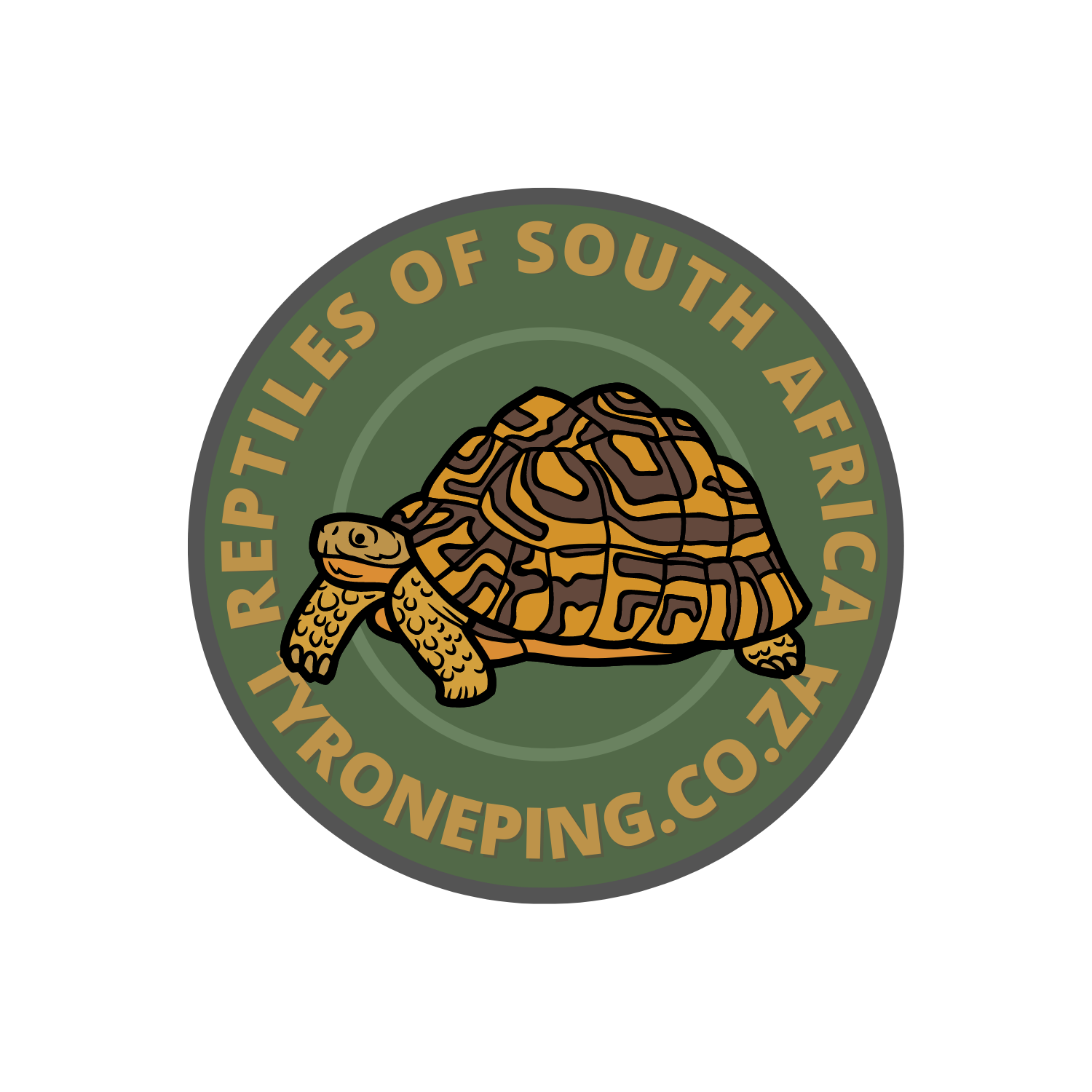



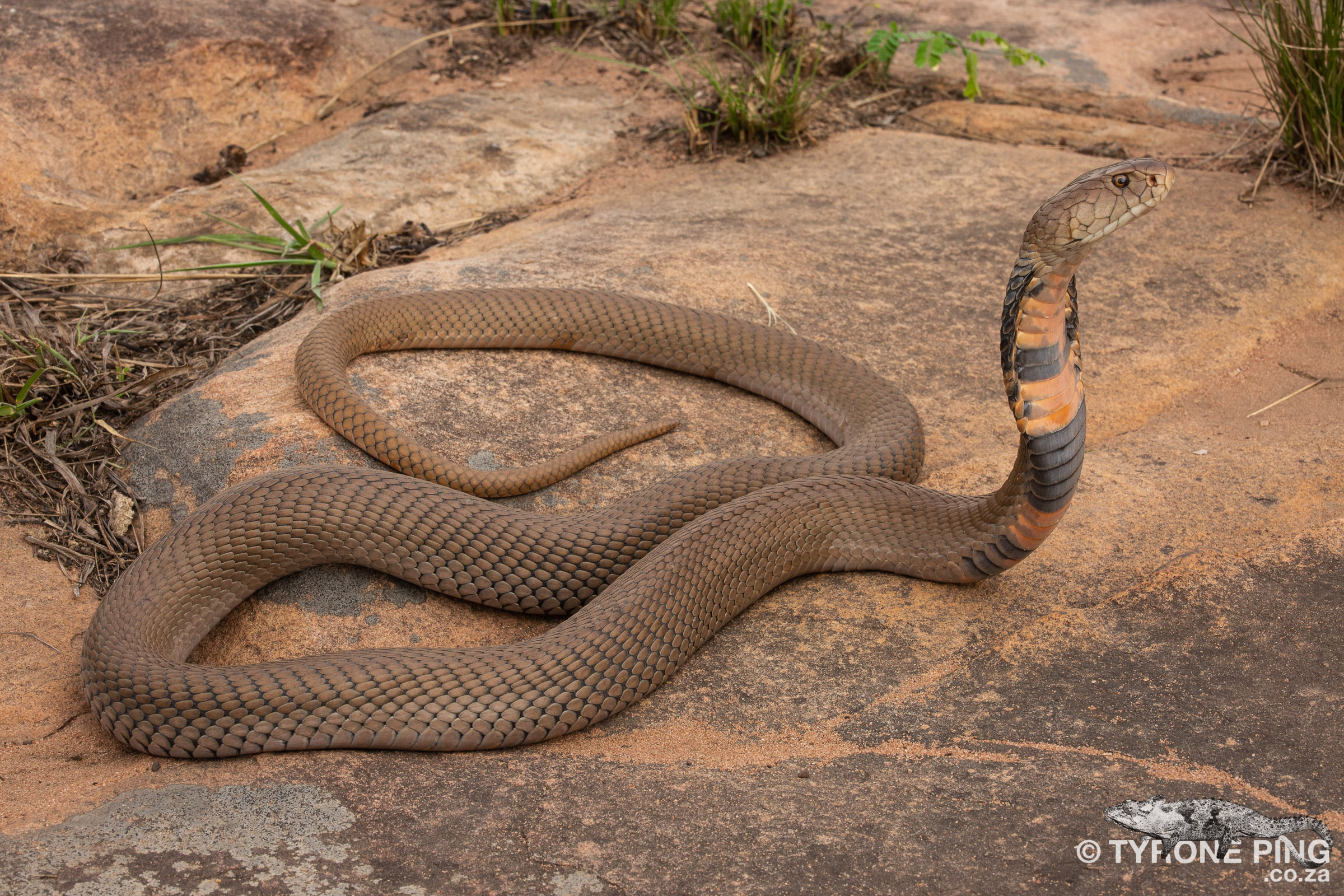
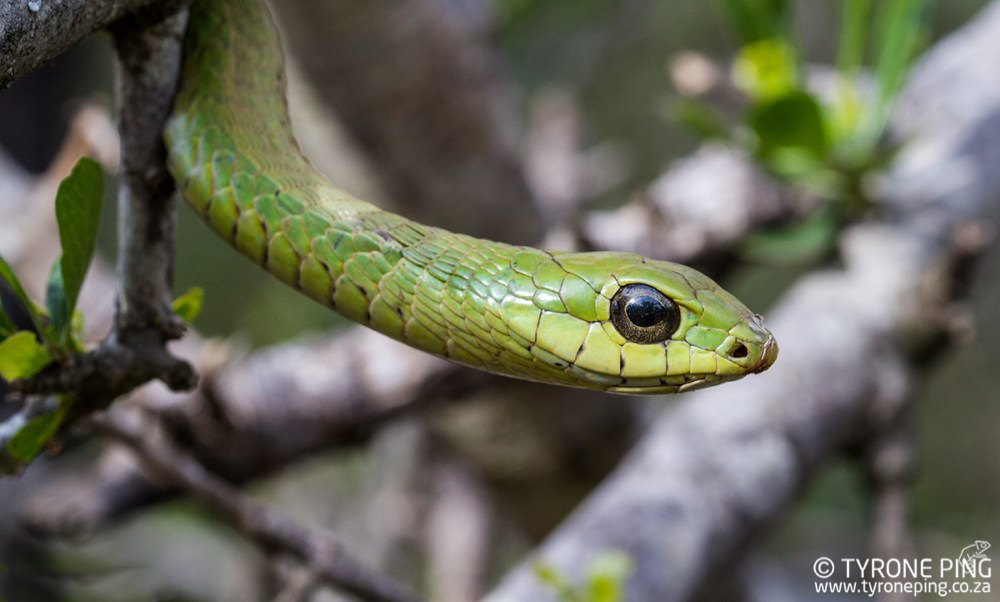






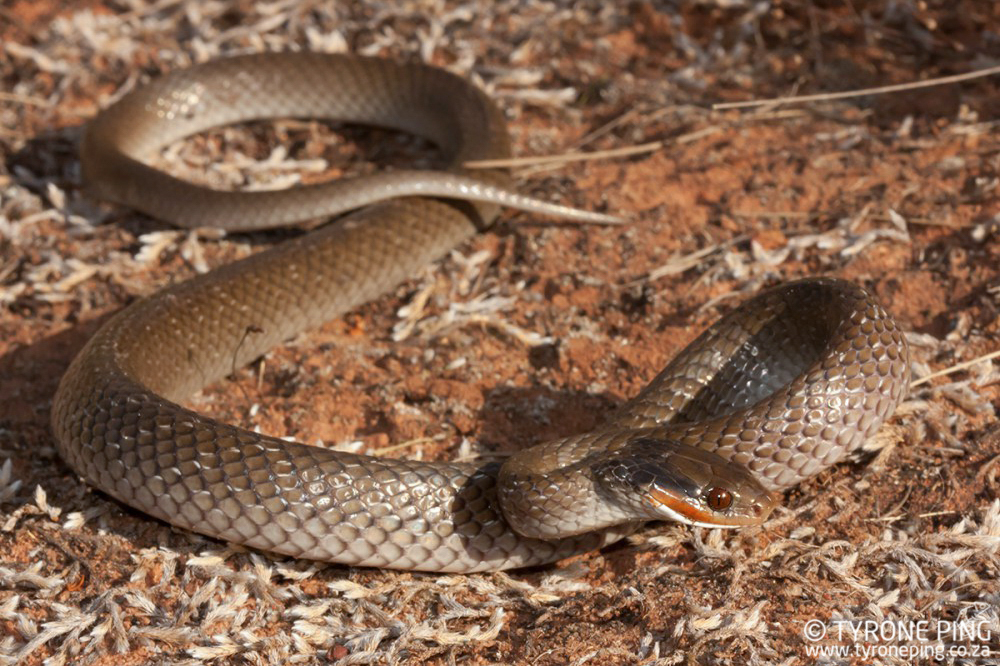




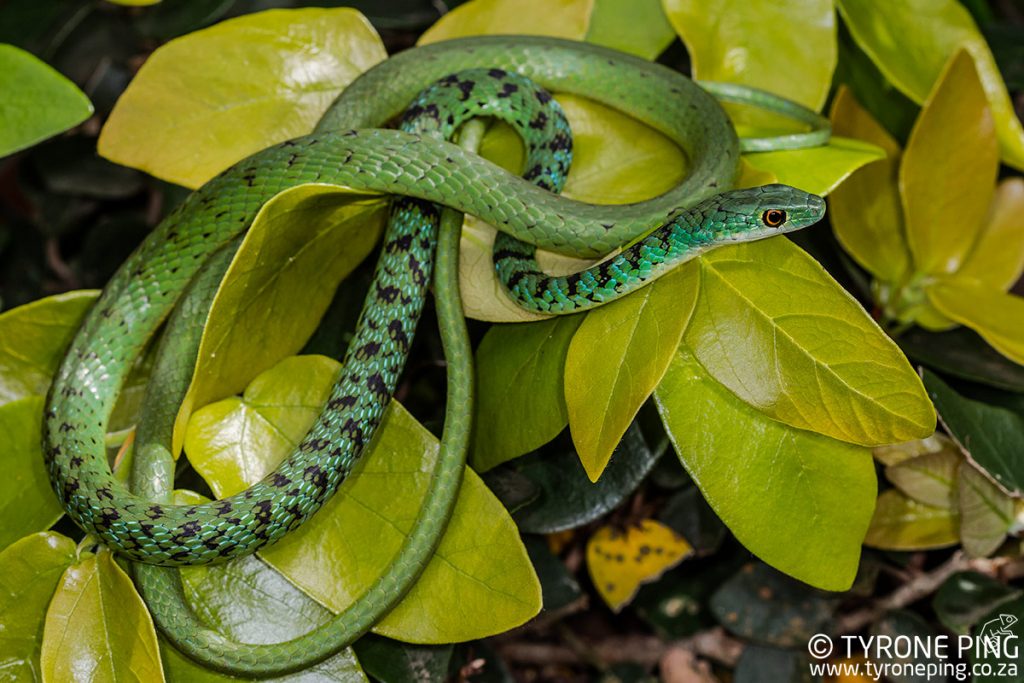
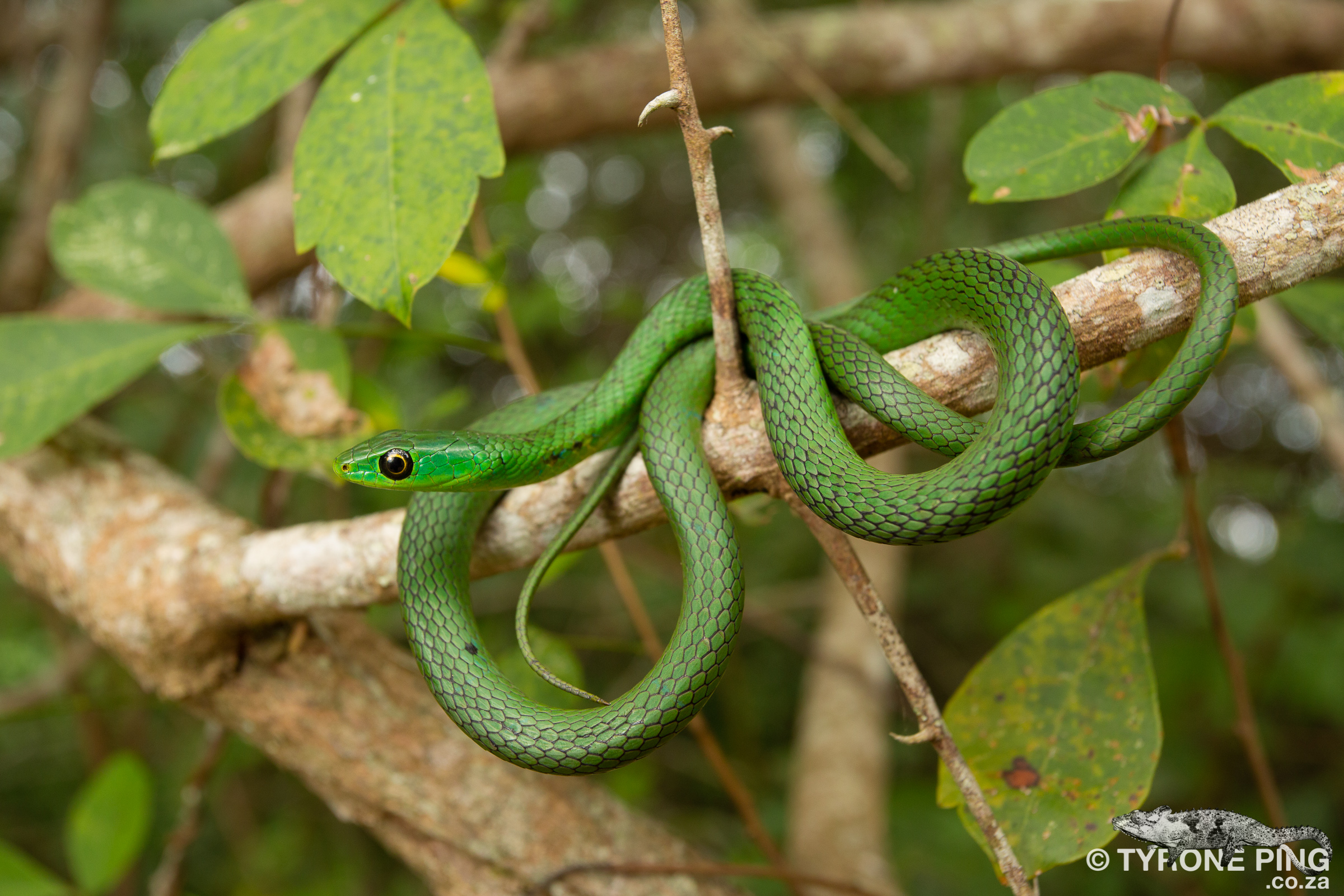




On 22/01/2018 whilst digging a trench at home I encountered a small, thin brightly coloured shiny blue snake +- 400mm underground. Very thin and at first thought it to be some or other earthworm, but this one moved in a typical snake like slithering manner and disappeared quickly into a surrounding soil cavity. Unfortunately no photo. Closes cousin by size appears to be the Peter’s Worm Snake.
My first encounter with such beautiful slithering creature. I am scared stiff when I see a snake at any distance and make time to get away. This tiny one actually intrigued me. Kind regards
Great Gerhard, what area did you see this snake? There are several similar looking species of the thread snakes and other lizards which can look identical.
It’s sad I’ve killed so many Bush snakes at home but of course I had no idea they are harmless even to this day I’m forced to do it at times cuz my fam is terrified of snakes, my mom esp, she just won’t understand how needless it is to kill an animal for no reason but I guess it is what it is the reputation of snakes is what they paying. 🧐
Hey I found. A small dead snake about 10cm in length and 1. Cm in width it’s was a Greyish color pl help and tell me what it ia
Hi there, very difficult to say from that description – could be a Herald snake. Do you perhaps have a photograph?
Hi, can you please tell me what type of snake this might be. The snske is very thin, long and greenish in colour.
Hi Chantelle, I don’t your a picture? You can email me on contact@tyroneping.co.za
Hi Tyrone i have just moved into a new home in Malvern Durban , we have a small stream in the backyard , i have seen two
snakes so far 1st a small black snake 30cm with a white mouth , very Aggressive then yesterday i saw a bright colored thin green snake about 60cm very fast , any thoughts on what type of snakes these are ? thank
Hi Sheldon, the dark snake you describe is likely a Herald Snake (they are not dangerous) and a Spotted Bush Snake (harmless) both of which are prolific in the area.
This morning my wife found a snake on top of the curtain rail. It was about 80 cm long. The gardener removed it from the house. He said it was a black mamba. We’re in Gillitts. Then this evening we were having dinner and I saw a snake poking his head out of the air brick in exactly the same place. I got closer, and saw another snake sticking his head out of the same air brick. So that’s at least 3 of them up there. The two I saw were very dark brown on top and white underneath, with the white and the brown distinctly separated. Any ideas on what they are? They can’t get up to the air brick from the outside, it is sealed. So they must have come inside and climbed up there somehow.
Hi Ashley, it is quite difficult to give an ID on that. Did the snakes have any markings that you saw? It would not be a Black Mamba. Most likely a Spotted House Snake or Brown House Snake. Do any of those snakes look familiar?
My number is 084 4922 542 you can give me a call/Whatsapp should you happen to see them again.
Hi Tyrone
I live along the Umbilo river near Paradise Valley. On Saturday afternoon, I was standing outside the house and I saw something behind the curtain. When I went to see what it was I saw a snake tail disappear into the ceiling through a small hole (size of a golf ball). It must have been about 40cm and greyish. My question is – which types of snakes are likely to be found in the ceiling or inside buildings? Any insight will be appreciated. Thanks, Leon
Hi Leon,
There are several species of snakes that will go into roofs typically after food like lizards, rodents and sometimes birds.
In that are Black mambas are very common as are Mozambique Spitting Cobras both are which are not uncommon to find in roofs.
Good morning,
I saw a small snake outside my house in Hillary last night, brown in colour, with creamish circles (like rings) around the body. The head is also slightly wider than the body. By the time I got the phone to take a pic, he decided to go into hiding. I have looked at the photo’s on various sites, but do not see the little one… Your help would be appreciated…. I do not do good with little creatures in my surroundings…
Hi there Pieter,
Most likely this was a Herald Snake see here: https://www.tyroneping.co.za/snakes-southern-africa/crotaphopeltis-hotamboeia/
The white dots can often be in high concentrations and appear to form rings around the body. When agitated they may flatten the head and strikeout. They are mildly venomous although not dangerous at all.
Very common in and around Durban at this time of year as things startto heat up.
Hi Tyrone, we presume according to the vet that our dog was sprayed in the eye by a spitting cobra (mozambique). We never saw anything but know where in the garden the dog was. Do you suggest we try get someone in to catch and release the snake as we have small kids?
We are in Glenashley, Virginia Bush is close by.
Hi Megan,
Mozambique Spitting Cobra’s are not very common in Durban North however, there seem to be common around Virginia Bush itself.
They do move around so they may not typically stay in the same place so trying to catch it without seeing it is really difficult.
I am in the Durban North area if you happen to see if do give me a shout – 0844922542.
HI Tyrone,
I found a brown snake in my garage yesterday morning, he seemed quite lazy and slithered into the garage as I drove out, I left the Garage doors open so he could leave but this morning he was back at the garage door curled in a sleepy ball. We are in the Glenhills area and have a large bush behind our complex. I also have guinea pigs and rabbits and I am worried he is something that likes to eat them. I could not see any distictive markings on him but to be honest I am apprehensive to get to close incase he is a stilleto and not a house snake.
Hi Chantal,
Thanks for teh comment tough to say. House snakes and Herald snakes are very common in the area. If you spot it again give me a shout on 0844922542 as I’m in the area.
HI T,
I found a brown snake in my garage yesterday morning, he seemed quite lazy and slithered into the garage as I drove out, I left the Garage doors open so he could leave but this morning he was back at the garage door curled in a sleepy ball. We are in the Glenhills area and have a large bush behind our complex. I also have guinea pigs and rabbits and I am worried he is something that likes to eat them. I could not see any distictive markings on him but to be honest I am apprehensive to get to close incase he is a stilleto and not a house snake.
i found a whitish/greyish snake with black v shaped bands neck upwards in the Amanzimtoti area , had an orange like fang …. what snake is this ? Is it dangerous?
Hi Brendan, it sounds like a Night Adder but tough from that description. They are venomous and bites are medically significant.
I’d like to know what common snakes are found around La Mercy?
Hi there,
Black Mamba
Green Mamba
Mozambique Spitting Cobra
Spotted Bush Snake
Eastern natal Green Snake
Rhombic Night Adder
Short Spouted Grass Snake
Brown House Snake
hi, i saw a green snake with bright redish orange eyes,it was very thin and about 20cm…ive tried to find a similar pic, but no luck on the internet- Durban
Hi there,
That would be a Spotted Bush Snakes up close as you can see the eyes are more orange than red.
Some reference: https://www.tyroneping.co.za/snakes-southern-africa/philothamnus-semivariegatus-spotted-bush-snake/
I have a SPORTED BUSH SNAKE roaming my yard. The snake was under a shelter near my house and I tried to chase it away but did not flee from the house. It simply wen and hid among the thons surrounding my yard. I read your article on these snake to finde out if they are harmful. I thank you guys letting me know that these snakes do not pose any threat to humans as they are harmless.
Awesome Katiso!
Hi, I woke up this morning and saw a snake outside my window. I think some animal or creature killed it. It looks bluish in colour which is odd for me. I live in Westville, KZN. I took a picture. I will email it. I would like to know what it is? I haven’t seen one this colour. Looks less than a meter and thin. Smallish head. It could not have been there for long because during the morning nothing was there. Thanks alot for the site. Its very interesting 🙂
Hi Yajna,
Thanks for your comment and email Spotted Bush Snake – Harmless. some reference: https://www.tyroneping.co.za/snakes/philothamnus-semivariegatus/
Hi Tyrone,
I found a little snake today while digging in the garden and he has me stumped as he looks so different to the usual suspects.
He is rather thin and agile and about 30cm long. he is light grey with a whitish belly and a slightly darker grey head. In searching through the snake book and your pics, I would say the closest description would be the centipede eater as his body/markings are all one colour (light grey)with a darker grey head, however his colouring is very different from the book and your pic of them, usually being orangey/brownish with a black head, ( I have also seen a centipede eater before, exactly like the book colourings in our garden too, and it was distinctly different in colour to this little grey one). Any ideas on what he could be? I did take a photo, but there doesn’t seem to be a place i can attach it. Many thanks!
Hey Jess, thanks for your comment. It does sound like a Centipede Eater s they can be rather variable and pale.
You’re welcome to drop me the photo in an email and I can confirm for you 100%!